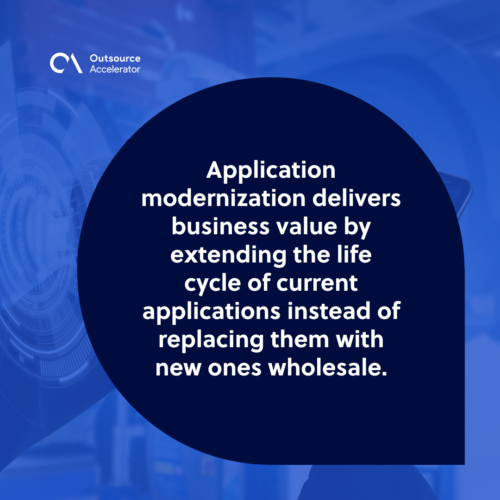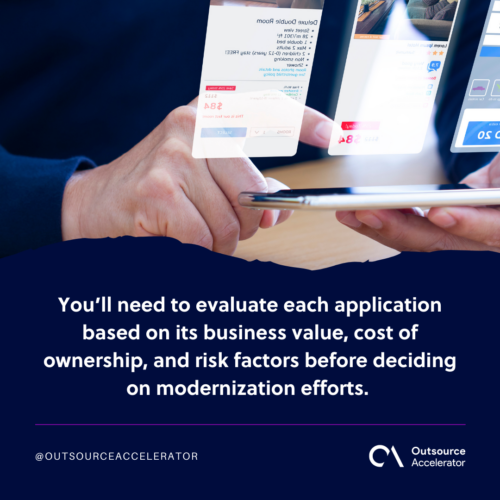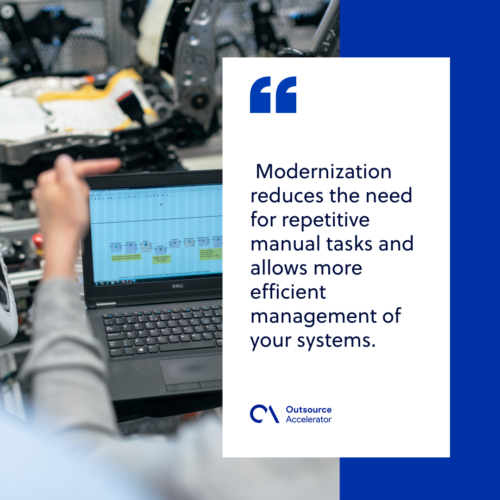The power of application modernization in the digital age

Technology is a major driver of business innovation, enabling companies to operate more efficiently and effectively. This impact has been greater with the rise of digital transformation.
Applications are particularly seen as the backbone of every business now. They drive a company’s operations and keep it competitive.
However, the problem is that many organizations still use legacy applications. These were built years ago using outdated technologies and techniques. Over time these applications need replacement or modernization to keep pace with new trends and developments.
Application modernization takes your existing applications and databases and makes them more efficient, scalable, and secure. This practice ensures that you use them to their full potential.
What is application modernization?
Application modernization isn’t just about upgrading or migrating existing applications to new platforms. It’s about optimizing your current application portfolio to increase business value.
Application modernization is done by making significant changes to source code and infrastructure. This may involve changing the programming language used to write the application or migrating it to newer hardware platforms.
Modernizing can also mean moving part of an application from one server to another or from one cloud provider to another.
Application modernization can be done at all levels of an application stack – from low-level code changes to high-level architectural changes.
The ultimate goal of application modernization is increased efficiency, scalability, and security. It delivers business value by extending the life cycle of current applications instead of replacing them with new ones wholesale.

Application modernization strategies
There are five options when it comes to application modernization strategies:
- Rehost – This strategy involves moving your application’s underlying resources from an onsite data center to the cloud.
- Refactor – For this strategy, the application codebase remains the same while it’s migrated to the cloud infrastructure. This adds cloud-based storage, computing, and network resources.
- Rearchitect – This strategy breaks down your legacy application’s architecture into smaller microservices that can be deployed and managed independently of each other.
- Rebuild – This strategy produces the most fundamental change in your application, as it completely rewrites the architecture to be cloud-based.
- Replace – Legacy applications with some functionality can be replaced with cloud-based ones for better security and cost-savings.
Key technologies for application modernization
These technologies are crucial for application modernization:
Cloud computing
Cloud computing is a core technology of application modernization. It’s a type of online computing that provides shared resources, infrastructure, and software to computers and other devices on demand.
Cloud computing services are delivered over the Internet and can be accessed via web browsers or mobile apps. It’s enabled organizations to reduce capital expenditures, increase utilization rates, and improve agility.
Cloud computing offers several capabilities, such as:
- Elasticity
- Scalability
- High availability
- Security
- Cost efficiency
- Increased flexibility
This application modernization technology has changed the way we build, deploy, and run applications. Cloud computing makes better use of existing resources and provides a wider range of options to developers.
Containers
Containers are a form of virtualization software technology. They allow you to quickly create and manage virtual software environments to encapsulate applications with their dependencies.
Containers package applications in such a way that they can be easily moved between different environments. These environments can be physical servers, virtual machines, or clouds (both public and private).
Containers have become popular as a part of application modernization for several reasons, including the following:
- They provide a way to easily run applications in a controlled environment with few resources.
- They make it easier for developers to package and deploy code by providing a consistent way to isolate workloads.
- They can be used as the basis for migration, modernization, and cloud initiatives.
- They are portable across environments; you don’t need to recreate them for each environment.
- They offer security because each container has its own isolated process space that doesn’t affect other containers or their host environment.
Microservices
Microservices refers to a software development and delivery technique that promotes the use of independent, self-contained services. As a form of application modernization, these smaller services are easier to manage than monolithic applications.
Microservices have their own unique functionalities and code paths but share a common language and data model. You can scale by adding more instances of each microservice as needed.
Microservices allow you to develop and deploy independent services with little overhead. This makes them easy to scale up or down depending on your needs. Each service can be developed by different teams with different technologies and deployed at their own times.
Automation
Automation is the key to achieving business agility, making it a top priority for many organizations.
Previously, manual processes were used to create applications. But in today’s digital world, businesses are quickly moving towards automated processes.
Automation improves productivity and promotes application modernization through two primary technologies:
- Artificial intelligence (AI) – This technology can help automate manual tasks through natural language processing (NLP). This allows computers to understand basic human speech to accomplish tasks.
- Machine learning (ML) – It refers to algorithms that learn from past experiences. You won’t need to explicitly program the machine for every possible scenario. ML is already being used by many companies today to adjust aspects of their product development processes.
Additionally, automated testing tools can be used to ensure that changes made during application modernization don’t break its existing functionality.
This is especially important when deploying changes that introduce new features or enhancements.
Steps in application modernization
Detailed below are the main steps an organization undertakes when initiating application modernization:
Discovery and assessment phase
The discovery and assessment phase of the application modernization process involves identifying the target application and gathering information about its current state.
You’ll need to evaluate each application based on its business value, cost of ownership, and risk factors before deciding on modernization efforts.
This phase includes:
- Identifying the business goals for modernization
- Analyzing existing systems to understand a project’s scope and complexity, including current processes, technologies, and data structures
- Understanding the organization’s culture, structure, and operational model
- Identifying key stakeholders and their perspectives on application modernization
- Analyzing the business environment, current IT landscape and future IT needs
Planning and design phase
Planning the process for application modernization involves the following actions:
- Defining the scope of the project
- Identifying all stakeholders involved
- Understanding what you want to accomplish
Some companies fold in aspects of this phase with the previous one.
Next, you’ll design an architecture for the new application or service that’s going to replace the legacy systems of your existing applications. The architecture should include a high-level design for each major component, as well as other supporting services like data stores and messaging.
The result of this phase is a high-level plan that details the approach to application modernization.
It also identifies risks and challenges that may prevent successful implementation, along with a thorough budget and timeline.
Development and deployment phase
During this phase of application modernization, you’ll do the work of developing new application architecture and deploying it for integration.
You can either build new application architecture from scratch or use an existing open-source solution that meets your needs. You can customize this to fit your organization’s requirements.
As part of this step, you should also determine if any third-party integrations have to be updated or replaced.
Once development is complete and testing has been performed, it’s time for deployment. You’ll deploy the software in production environments where your users can access it (usually over the Internet).
This process includes configuring servers, network infrastructure, and security systems so they’re ready for use.
Operations and maintenance phase
During this phase of application modernization, organizations will begin to realize the benefits of updating their legacy applications and systems.
At the same time, this can be a burdensome period. The organization must deal with adjusting to the new technology. Business processes may have to be changed, and leaders will also need to train people on how to use and interact with the new system.
If insufficient time is allotted for training and onboarding, this can lead to the failure of the application modernization project.
You’ll also need to work to maintain your new application systems. This includes monitoring and diagnostics.
- Monitoring – It refers to collecting and analyzing metrics to determine the health of an application or system. Metrics include data on response time, error rates, and other factors that help you identify when it might be time to scale your infrastructure.
- Diagnostics – These are used to pinpoint specific issues within an application. They could involve running tests against the application’s components or looking at logs generated by the system under investigation.
It’s important that you have a good quality assurance process in place for application modernization. Without one, fixing bugs and releasing apps into production will take longer than expected.

Benefits of application modernization
Application modernization comes with a multitude of unique benefits for several departments within an organization.
Take a look at them below.
Benefits for development teams
Here are the benefits of application modernization for development teams:
- Reduced technical debt – Technical debt, like poor code quality, makes it difficult for developers to work on applications. Modernization fixes these issues and improves performance.
- Increased agility and flexibility – Modernized applications can be extended with new features that respond better to changing business requirements.
- Access to new tools and technologies – Application modernization allows developers to use different languages and frameworks beyond those offered by a single technology stack.
Benefits for IT operations teams
Here are the benefits of application modernization for IT operations:
- Improved scalability – Application modernization reduces the number of servers needed to run your programs, allowing you to scale more quickly and easily.
- Enhanced security – The latest versions of application software include improved security features to protect against known vulnerabilities and threats.
- Better resource utilization – Modernization consolidates all your applications in one platform and manages them through one interface.
- Streamlined operations – Modernization reduces the need for repetitive manual tasks and allows more efficient management of your systems.
Benefits for business leaders
Here are the benefits of application modernization for business leaders and organizations as a whole:
- Increased agility and speed to market – A faster time to market increases your competitive edge with other businesses in your industry.
- Improved customer experience – Faster, more intuitive, and more engaging interfaces are easier for customers to use and be satisfied by.
- Increased productivity – Through application modernization, you can increase company productivity and use time more effectively.

Why do companies need application modernization?
With the growing complexity of the IT environment, many companies are looking for ways to simplify their infrastructure. Application modernization achieves this by aiming to improve the performance and scalability of applications.
There are two main reasons why companies need application modernization:
- First, to ensure that applications can meet the needs of users and end-users. While applications are typically developed to meet the needs of businesses, they may not be able to adapt to changing requirements over time.
They’ll also need to be equipped with new features to help users do their jobs better.
- Second, to improve security and compliance with industry regulations. As technology advances, so do the threats against it, including malware attacks and cyber hazards.
It’s rare to find a company that hasn’t been affected by some form of cyberattack in recent years. This environment has led many organizations to take steps toward greater protection through application modernization efforts.







 Independent
Independent




